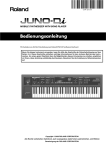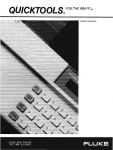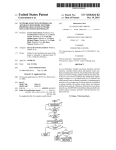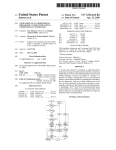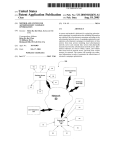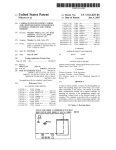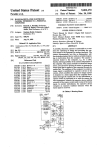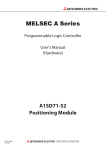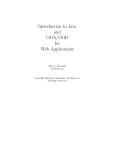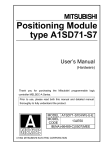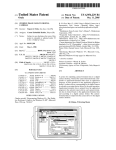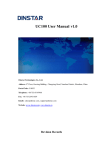Download Electronic still camera for capturing and categorizing images
Transcript
USO0RE41524E (19) United States (12) Reissued Patent (10) Patent Number: US (45) Date of Reissued Patent: Parulski et al. (54) ELECTRONIC STILL CAMERA FOR FOREIGN PATENT DOCUMENTS CAPTURING AND CATEGORIZING IMAGES (75) Inventors: Kenneth A. Parulski, Rochester, NY (US); Thomas A. Napoli, Rochester, NY (US); David M. Lewis, Phoenix, AZ EP 0 640 938 A2 EP JP 640938 A2 * 3/1995 5-044460 * 12/1993 JP 5-344460 User’s Manual (excerpts). Eastman Kodak Company, 1991, NY (US) Filed: 1992* “TIFF/EP, A Flexible Image Format for Electronic Still 09/313,535 May 13, 1999 Cameras”, by Ken Parulski and George Lathrop, Eastman Kodak Company, Rochester, NY. Preprint from IS&T’s 48th Annual Conference, May 1995* Operation and Maintenance Manual for the Kodak HaWkeye II Imaging Accessory, Part 6364101, Catalogue No. 144 Related US. Patent Documents Reissue of: (64) Patent No.: Appl. No.: 5,633,678 May 27, 1997 08/574,756 Filed: Dec. 20, 1995 Issued: (51) 12/1993 Kodak Professional Digital Camera System (DSC 100) (73) Assignee: Eastman Kodak Company, Rochester, Appl. No .: 8/1994 OTHER PUBLICATIONS (Us) (21) (22) RE41,524 E Aug. 17, 2010 7903. Eastman Kodak Company, Federal Systems Divi sion.* * cited by examiner Primary ExamineriQuochien B Vuong Int. Cl. H04N 5/76 (74) Attorney, Agent, or FirmiDavid M. Woods (2006.01) (57) ABSTRACT (52) US. Cl. ............................. .. 348/231.5; 348/207.11; (58) Field of Classi?cation Search ........... .. 348/207.99, of subjects and categorizes the image according to subject 348/207.1, 207.11, 222.1, 231.99, 231.1, 348/231.2, 231.3, 231.5, 231.7, 239, 552; matter. The camera comprises an image sensor for capturing an image, a converter stage for converting the image into 348/231.2; 348/239; 348/552 An electronic camera captures images representing a variety digital image data, and a memory for storing a plurality of H04N 5/30, 5/225 categories providing classi?cation of the images by subject. See application ?le for complete search history. A processor in the camera has the capability of assigning the References Cited plurality of categories to the images captured by the camera, U.S. PATENT DOCUMENTS images. A user selects one or more categories for a plurality (56) With each category providing a subject classi?cation for the of images prior to capture, and an output image signal is then generated including the digital image data Corresponding tO 4,524,381 A : 6/1985 Konishi ..................... .. 386/38 4,574,319 A * 3/1986 Konlshl ................. .. 348/2316 i * 233:5?‘ e211‘ " a Captured image and the particular Category Selected by the ; user. The categories can be default identi?ers stored in the 5’l53’729 A * “M992 sgistolet ' " 3480316 5’335’072 A * 8/1994 Tanaké'l'é't't'li "" " " 3480313 5’477’264 A * 0/1995 Sarbadhikar'i """"" " 348/23'l memory, or canbe names, text (i.e.,accountnumber), and/or graphics overlays (1.e., company logo) entered via a host computer and uploaded to the camera memory before the 5,502,486 A * 3/1996 Ueda et a1. Plcmresaretaken' 5,515,101 A * 5/1996 Yoshida 5,796,428 A * 8/1998 Matsumoto et a1. ....... .. 348/231 ...... . . . .. 348/239 . . . . . . . . . . . . . . . . .. 348/232 26 Claims, 6 Drawing Sheets INPUT SECTION (A) COMPRESSION AND RECORDING SECTION (B) '5 [IMAGE BUFFER I/IB ' 5:378‘??? sled/12f 2s TI pnocesson l2 2 ,o/ Z2 r | ' FRAME! t f” I /30a 28 I / "" """ _' FLASH UNIT I 2% t t#____ PROCESSOR |||| m1 PROCESSING 24'’ ALGORITHMS 200 1 I [E],/ BEE/M51’ __. '9 1. s SHUTTER BUTTON ‘2| >-~ STATUS 4 35" ‘u .4 '“ —_- FIRMWARE 31/ : MEMORY J24 g2; 12,. _“ DISPLAY .__50 13E 2"; 29 m _ RAM ya?” *1 “55%?” f US. Patent Aug. 17, 2010 525‘ Sheet 3 of6 / 50 PI 5,2." >- "a - X? E AAA?! I535"?! II?! If‘? " £1 " 528"’ US RE41,524 E 52a 15E’; 5Q?” 5%; iijyi / 1 5 54 55b F I G. 3 /so usER TURNS o~ cAMERA /6, PHS‘QgJQAiZw GROUP ? USER SELECTS APPROPRIATE CATEGORY ICON AND CHOOSES DESIRED CATEGORY USER CONNECTS CAMERA I . 62 _ OR MEMORY CARD To / THE HOST coMPuTER usER TAKES PIcTuRE BY DEPRESSING SHUTTER BUTTON / 65\ usER OPENS cAMERA APPLICATION AND CHOOSES oEsIREo cATEeoRIIEsI 63 IMAGE ISWISTLOIEEQESIOEILE ALONG CHOSEN BY THE USER YES MORE IMAGES FoR, THIS \NO 66 \ IMAGES FROM APPROPRIATE CATEGORIES ARE DOWNLOADED To PROPER FOLDERS ACCORDING To THE CATEGORY IN EACH IMAGE FILE CATE?GORY F164 US. Patent Aug. 17, 2010 US RE41,524 E Sheet 4 0f 6 USER INPUTS CATEGORIES, AND RELATED TEXT/ GRAPHICS ON HOST ~70 USER DOWNLOADS CATEGORIES/TEXT/GRAPHICS TO CAMERA USING CABLE OR MEMORY CARD USER TURNS ON CAMERA USER SELECTS APPROPRIATE CATEGORY ICON AND CHOOSES DESIRED CATEGORY ' YES I _ usER. TAKES PICTURE BY -/74 OEPREssING sHUTTER BUTTON 75 ANOTHER PHOTOGRAPHIC T / As IMAGE IS PROCESSED, OPTIONAL TExT GROUP _P / GRAPHICS ANO/OR DATE TIME IS OVERLAYED INTO IMAGE IF ENABLED FOR THE CATEGORY CHOSEN BY UsER NO I / 76 IMAGE IS sTOREO IN FILE ALONG wITH CATEGORY NAME AND OPTIONAL TExT FOR THE CATEGORY CHOSEN BY THE USER YES/ MORE IMAGEs FO THIS CATEGORY NO 64 usER CONNECTS CAMERA OR MEMORY CARD TO THE HOsT COMPUTER USER OPENS CAMERA APPLICATION AND I CHOOSES DESIRED CATEGORIIESI FIG. 5 66\ IMAGES FROM APPROPRIATE CATEGORIES ARE ‘ DOWNLOADED T0 PROPER FOLDERS ACCORDING TO THE CATEGORY NAME IN EACH IMAGE FILE US. Patent Aug. 17, 2010 Sheet 6 of6 US RE41,524 E STORED IMAGE m; SELECTED CATEGORY H23 H CAPTURED IMAGE CLAIM #|23 --LT____> + GRAPHIC Fly-by-night M N019, 1995 Insurance Co. / W115 0m Cluim #IZZ» DATE/TIME F168 DATE 50/ ON OFF TIME ON OFF TEXT ON OFF 56 0’, ,29 f 54 US RE41,524 E 1 2 The Kodak Professional Digital Camera System (model ELECTRONIC STILL CAMERA FOR CAPTURING AND CATEGORIZING IMAGES DCS-100) included a digital camera tethered by cable to a separate digital storage unit (DSU). The DSU, similar to the computer 4 of FIG. 1, contained a hard drive for storing Matter enclosed in heavy brackets [ ] appears in the original patent but forms no part of this reissue speci?ca images, a small image display, and a keypad for manipulat ing the images. For images that had already been captured by tion; matter printed in italics indicates the additions made by reissue. the camera, the system included a “tag” feature that allowed a user to ?ag selected images for later display or for upload ing from the DSU to another computer. Suppose that a user FIELD OF THE INVENTION wanted to tag a couple of already-captured images for later viewing or uploading. The ?rst of the images would be brought up on the display and a “tag” button on the keypad This invention pertains to the ?eld of electronic imaging systems, and in particular to a digital electronic still camera of the type that is used with a host computer. would be pressed, and so on with the other images that are to be tagged. Then if the user presses a “?nd tags” key on the BACKGROUND OF THE INVENTION keypad, the ?rst of the tagged images is displayed (and/or As understood in the prior art, a digital electronic still uploaded). With a second press of the “?nd tags” key, the camera is a device which uses an electronic sensor to capture second tagged image is displayed (and/or uploaded), and so an image; signal processing to represent the captured signal numerically; and some storage device to preserve the numerical image data. It is further known for a digital elec on. Another embodiment of this camera, the Kodak Hawkeye 20 tronic still camera to use a removable storage device, such as image after the image was taken, and to add a “note” text string to the image ?le. Both cameras allowed a simple divi an integrated circuit memory card, to store images. For instance, US. Pat. No. 5,016,107 describes an electronic still sion of already-captured images into “tagged” and “not tagged” images and required a pattern of keystrokes camera utilizing image compression and providing digital storage in a removable memory card having a static random access memory. In this camera, the integrated circuits in the removable memory card store image data and a directory 25 dling. Anything more complex in the way of data organiza Coordination between a digital camera and a computer is tion requires, as shown in FIG. 1, the use of a special 30 electronic still photography system useful for inputting images to a computer. The system includes an electronic camera 1 with an electronic sensing section 1a, a digital processing section 1b, a memory card slot 2, and a remov able memory card 3; and a host computer 4 with a built-in memory card reader 5, a printer 6a, a display 6b, a keyboard data entry device 7 and a disk drive 8. Images are captured by the sensing section 1a in the camera 1, manipulated in the processing section 1b, stored on the memory card 3, and transferred from the card 3 to the host computer 4. The soft ware used to control the sensing and processing sections 1a and 1b in the camera is located in ?rmware memory 10 in the camera 1. The application software used to control the play back operations of the host computer is supplied, at least in part, by the camera manufacturer. For instance, the manufac 35 SUMMARY OF THE INVENTION The present invention is directed to overcoming one or more of the problems set forth above. Brie?y summarized, according to one aspect of the present invention, an elec tronic camera captures images representing a variety of sub 40 jects and categorizes the image according to subject matter. The camera comprises an image sensor for the images, a converter stage for converting the images into digital image data, and a memory for storing a plurality of categories pro viding classi?cation of the images by subject. A processor in 45 the camera has the capability of assigning the plurality of categories to the images captured by the camera, with each category providing subject classi?cation of one or more images. A user then interacts with a user control on the cam era in order to select one or more of the categories for the 50 images, and an output image signal is then generated includ ing the digital image data corresponding to the images and the one or more categories selected by the user control. are stored as sequentially numbered images, it can be di?i cult and time consuming to locate a group of images of interest from all of the images stored in the camera. In a typical usage, an insurance adjuster may take a number of photos in processing a number of different claims during one day’s operations. It would be desirable to be able to identify the images of each group, for example by claim number or application program in the host computer 4 to organize and sort the image data. Consequently, it would be desirable to have an electronic still system that could handle image con tent more ef?ciently in the ?eld than is presently the case. turer may provide a special disk or memory card that comes with the camera. The application software is transferred to the computer hard drive 8, and then downloaded to a com puter random access memory (RAM) memory 9a, where the program is used by a central processing unit (CPU) 9b. Digital cameras, such as the Kodak Digital Science DC40TM camera sold by Eastman Kodak Company, allow almost a hundred images to be stored. Because the images subsequent to capture for every image of interest. In particular, the tagging feature functioned more as a post capture data gatekeeper than as a useful tool for image han locating the data. generally known in the prior art. FIG. 1 shows a known II camera, also allowed the user to type in a name for any one 55 The advantage of the invention is that the known provi sion of a simple post-capture “tag” is enlarged into useful pre-capture categories that can effectively manage images according to variable subject content. According to this invention, a digital camera includes a display-based “tag” icon/feature which the user can set to an appropriate cat egory before taking a group of pictures. The category names 60 can be defaults, or can be names and optional text (i.e., account number) and/or graphics overlays (i.e., company client name. It may be further desirable to allow this information, along with the date and time or a company logo) entered via a host computer and uploaded to the cam logo, to be optionally included with the image data. This era before the pictures are taken. When the user selects a ensures that any prints made from the camera can be easily particular category, the category name is stored along with the image data in the image ?le, and any text and graphics identi?ed. Such processing of the captured images is today performed in a ho st computer, such as the ho st computer 4 in FIG. 1. 65 logo, as appropriate, are overlaid onto the image. When downloading the images to a host computer, the user can US RE41,524 E 3 4 select a category and download only the images Which have log image charge information corresponding to the particu lar image is generated in respective photosites. The charge a particular category name, or the images can be stored in folders labeled With each category name. information is applied to an output diode 14, Which converts the charge information to analog image signals correspond ing to respective picture elements of the particular image These and other aspects, objects, features and advantages of the present invention Will be more clearly understood and appreciated from a revieW of the folloWing detailed descrip tion of the preferred embodiments and appended claims, and captured. The analog image signals are applied to an A/D converter 16, Which generates digital image data from the analog input signals for each picture element. The digital image data is by reference to the accompanying draWings. BRIEF DESCRIPTION OF THE DRAWINGS applied to an image buffer 18 for storing one or more images, albeit shoWn in FIG. 2 as a random access memory FIG. 1 is a diagram of a knoWn electronic imaging system incorporating a digital camera for inputting images to a host (RAM) With storage capacity for a plurality of still images. A programmed control processor 20 generally controls the input section A of the camera by initiating and controlling computer. exposure (by operation of the diaphragm and shutter (not shoWn) in the exposure section 10), by controlling the ?ash unit 11, by generating the horizontal and vertical clocks FIG. 2 is a block diagram of an electronic camera con?g ured according to the invention to process and categorize images. FIG. 3 is a diagram of the status display panel and the user control sWitches used in the camera shoWn in FIG. 2. FIG. 4 is a process diagram for categorizing images 20 according to default parameters stored in the camera shoWn in FIG. 2. Would typically be effected by using ambient light informa FIG. 5 is a process diagram for categorizing images according to externally generated parameters supplied to the camera shoWn in FIG. 2. 25 Once a certain amount of digital image data has accumu lated in the image buffer 18, the stored data is applied to a 30 FIG. 9 is an additional diagram of the status display panel 35 sion algorithms, such as the Well-known JPEG (Joint Photo DETAILED DESCRIPTION OF THE INVENTION 40 Because electronic still cameras employing electronic sensors are Well knoWn, the present description Will be directed in particular to elements forming part of, or cooper sion is shoWn in the camera of FIG. 2, compression is not a ating more directly With, apparatus in accordance With the the removable storage device is a memory card 24. While a memory card 24 is shoWn in this system as the storage device, other devices may be used, such as a ?oppy disk magnetic medium, a small hard drive, or optical storage (in 50 in such arts. FIG. 2 shoWs an electronic still camera capable of catego the latter cases, suitable conventional reading/Writing appa ratus Would be provided in the camera, e.g., magnetic or optical read/Write head, etc.). A representative memory card is a card adapted to the PCMCIA card interface standard, such as described in the PC Card Standard, Release 2.0, rizing images as taught by the invention. The electronic still camera is divided generally into an input section A and a 55 published by The Personal Computer Memory Card Intema tional Association, Sunnyvale, Calif., September 1991. The memory card 24 accordingly contains solid state memory 24a, such as Flash EPROM memory, Which the card uses to not shoWn, the exposure section 10 includes conventional optics for directing the image light through a diaphragm, compression algorithm from the memory 28 to the digital image data, and sends the compressed data to a removable storage device via a signal port 26. HoWever, While compres necessary feature, and uncompressed data could be stored instead in the removable storage device. In this example, the signal port 26 is a card interface and present invention. Elements not speci?cally shoWn or described herein may be selected from those knoWn in the art. Certain aspects of the embodiments to be described are compression and recording section B. The input section A includes an exposure section 10 for directing image light from a subject (not shoWn) toWard an image sensor 12. A ?ash unit 11 may be used to illuminate the subject. Although according to any one of a number of knoWn image compres graphic Experts Group) discrete cosine transformation based compression algorithm. The processor 22 applies the ture using categories. provided in softWare. Given the system description as described in the folloWing materials, all such softWare implementation is conventional and Within the ordinary skill programmed digital signal processor 22, Which controls the throughput processing rate for the compression and record ing section B of the camera. The algorithms and other oper ating code used by the processor 22 are stored in an algo rithm memory 28. The digital signal processor 22 compresses each still image stored in the image buffer 18 FIG. 8 is an example of an image display With customized category information overlaid into the image. and the user control sWitches set up for activating an overlay feature. FIG. 10 is an example of an image ?le management struc tion from a photocell 19, and a shutter button 21 alloWs the user to initiate a capture cycle. The processor 20 also receives date and time information from a date/time genera tor 20a. FIG. 6 is an example of categories that are customized from a host computer. FIG. 7 is an example of a ?le format resulting from cus tomized categories. needed for driving the sensor 12 and for clocking image information therefrom, and by enabling the A/D converter 16 in conjunction With the image buffer 18 for each signal segment relating to a picture element. Exposure control 60 store image data ?les. According to this invention, the digital camera includes a Which regulates the optical aperture, and a shutter, Which categorization feature Which enables a user to establish an regulates exposure time. The sensor 12, Which includes a appropriate category, providing classi?cation of the images by subject, before taking a group of pictures. The category tWo-dimensional array of photosites corresponding to pic ture elements of the image, is a conventional charge-coupled device (CCD) using, e.g., either Well-known interline trans fer or frame transfer techniques. The sensor 12 is exposed to image light to capture a particular image; accordingly, ana 65 information can be default code symbols (A,B,C, etc.), or can be extemally-generated category information, such as names and optional text (i.e., account numbers) and/or graphics overlays (i.e., company logos), Which is entered via US RE41,524 E 5 6 a host computer and uploaded to the camera through the signal port 26 before the pictures are taken or via cable con nection. After the user selects a particular category, the image delete icon 52f.) The user control sWitches 29 include a toggle sWitch 54 and a select button 56. The toggle sWitch 54 is used to toggle to a setting once an icon has been acti image is captured and the category information is stored in the removable storage device along With the image data in the image ?le, and any text and graphics logo, as appropriate, are overlaid onto the image. When doWnloading vated by the select button 56. For example, if the ?ash mode icon 52d is highlighted and shoWing that it is the currently active control, pressing the select button Would activate the tag icon 52a and make it the currently active control. While not important to this invention, other information the images to a host computer, the user can select a particular displayed on the status display 30 might include typical pho tographic data, such as shutter speed, aperture, exposure category and doWnload only the images Which have a par ticular category identi?er, or the images can all be doWn loaded and stored in ?le folders labeled With each category bias, color balance (auto, tungsten, ?uorescent, daylight), high/loW resolution, loW light, exposure modes (aperture name. preferred, shutter preferred), and so on. Moreover, other information unique to this type of camera may be displayed. For instance, the memory card 24 Would ordinarily include a Consequently, the memory card 24 contains additional memory to store header ?les 24b containing category infor mation helpful in providing classi?cation of the images by subject matter. Such category information may include directory signifying the beginning and ending of each stored default tag codes, such as simple alphabetic identi?ers A, B, image. This Would shoW on the display 30 as either (or both) the number of images stored or the number of image spaces remaining, or estimated to be remaining. C, D, etc., or alphanumeric names that can be associated With speci?c images according to subject matter. The header ?les 24b can also contain strings of text that identify particu 20 If externally generated category information is present in lar images and separate graphics images that signify or oth the header ?le 24b on the card 24, it can also be identi?ed on erWise identify subject matter. The header ?les 24b can also contain instructions to overlay all or part of the category the status display 30. For instance, the externally generated category information, such as names, text strings, and graph ics images can be identi?ed and displayed if the status dis information into the image data ?les 24a, or, alternatively, 25 play 30 has the appropriate display capability. Alternatively, algorithm memory 28 Which accomplishes the overlay, and the toggle sWitch 54 can be used to cycle through alphanu then stores all or part of the category information With the image data. It is a further feature of this invention that the 30 meric names that are provided from the host computer and displayed on the segmented section 52b. Selecting any one name then automatically accesses any text string or graphics image that might be associated With the name in the instruc the digital signal processor 22 can access an algorithm in the externally generated category information can be supplied to the digital camera through the signal port 26. Such exter nally generated category information can be stored in the Card Information Structure (CIS) of the PCMCIA Format (as described in the aforementioned Release 2.0), in the header data ?le 24b, or in a portion of the memory space of the memory 24a used to store the image data. The camera also contains a memory section 31, including ?rmWare memory 32a With operating code for the camera, as Well as RAM instruction memory 32b connected to receive code from the memory card 24. When the memory card 24 is inserted into the camera, the processor 20 uses the ?rmWare algorithms in the memory 32a to determine if the memory card 24 contains externally generated ?les Which can be used tion memory 32b, and stores such strings or graphics image With the digital image data. The camera may also have the additional feature of overlaying a text string, or date and/or time from the date/time generator 20a, into the image. 35 40 by the camera. If not, the ?rmWare algorithms supplied With the camera in the memory 32a are used by the programmable processor 20. In particular, the default category parameters 45 Whether or not the date/time or text string is overlaid in the images of any particular category can be controlled by over lay control information for each category present in the header ?le 24b. Altemately, this can be done from additional icons in the panel con?guration 50 and from the user control sWitches 29, as shoWn in FIG. 9. Date, time, name, and text are separately activated by the toggle sWitch 54, and “on” (overlay active) or “off” icons are activated by the select sWitch 56. It is assumed that an uploaded graphics image Would alWays overlay into the image, but if this is not alWays desirable, then a separate graphics icon may be provided for are stored in the ?rmWare memory 32a and accessed by the overlay control. processor 20. If the card does contain appropriate externally generated category information, hoWever, these are doWn The process for categoriZing images according to default parameters is shoWn in FIG. 4, and the process for categoriZ loaded from the header ?le section 24b of the card 24 to the RAM instruction memory 32b and used by the program mable processor 20 in place of some portion of the ?rmWare algorithms supplied With the camera from the ?rmWare ing images according to customiZed, externally generated 50 When the camera is ?rst turned on, the “tag” icon 52a Will be shoWn only in outline form (step 60). The inner part of the memory 32a. In this Way the camera can execute customiZed category de?nitions Which provide higher quality or more complex categoriZation of pictures. parameters is shoWn in FIG. 5. Referring ?rst to FIG. 4, 55 “tag” icon 52a Will ?ll to indicate When the user has posi tively selected the tag feature by activation of the user con trol sWitches 29. In the default mode, there are a predeter User control is provided by a status display 30 connected to the control processor 20 for displaying information useful mined plurality of possible categories, for example, ?ve alphabetic categories A,B,C,D,E and NONE (or OFF). With in operation of the camera, and by a set of user control the tag icon 52a activated, the user Will select categories A,B,C,D,E,NONE (repeat sequence A,B, etc.) by pressing sWitches 29. The set of user control sWitches 29 are also connected to the processor 20 for entering, highlighting, and selecting information displayed on the status display 30. In accordance With invention, the status display 30 is a liquid 60 causes a different tag code to be displayed on the alphanu meric segment 52b. crystal display (LCD) having a panel con?guration 50 such After the tag is selected, the user can activate other icons by use of the select button 56. Then, When the shutter button as shoWn in FIG. 3, Which includes a “tag” icon 52a, and an alphanumeric segmented section 52b. (The panel con?gura tion includes other typical icons, such as a battery level icon 52c, a ?ash mode icon 52d, a self-timer icon 52e, and an the toggle sWitch 54 (step 61). Each press of the sWitch 54 65 21 is pressed, the selected category (tag) is associated With the digital image data (steps 62, 63). Then the steps 62, 63 are repeated for any additional images in the same category. US RE41,524 E 8 7 After the images from the camera are stored on the If a new category is desired, the process reverts to step 61. When all the images are captured, the user connects the camera (by cable) or the memory card 24 to a host computer memory card 24, the card is inserted into the computer memory card reader 5 (see FIG. 1). In applications where the (step 64), such as the host computer 4 illustrated in FIG. 1. memory card may contain category information which can Using software supplied by the camera manufacturer, the be used by the computer, the computer uses the software user opens a camera application and chooses the desired supplied with the camera to check if the memory card con category (step 65). Then the images from appropriate cat tains such information. If the card does contain appropriate category information, this information is downloaded from the card to the RAM instruction memory 9a and used by the CPU 9b in combination with the software algorithms from the hard drive 8. This allows a quick and convenient way of egories stored in the camera, or the memory card 24, are downloaded to proper ?le folders according to the category data stored with the digital image data in each ?le (step 66). The user may also customize the tags using the host com puter. As shown in the process diagram of FIG. 5, a user categorizing the images accessed by the computer, without inputs category information, such as category names, and related text or graphics images, from the ho st computer (step 70). The user then downloads the category information to the requiring further intervention from the host computer. According to the invention shown in FIG. 2, the images camera (step 71). This may be done through a tethered con nection to the camera, or by writing appropriate ?les into the removable memory, rather than a cable interface. Therefore, are transferred from the camera to the computer via the the camera does not have to be in the same location as the memory card 24. The user turns on the camera (step 72), and selects an appropriate category (step 73). At this stage, the computer. This makes it possible to view the images from user can also decide to activate the overlay capability for the camera in many different locations, on many different date, time, text, and graphics images. The picture is taken (step 74), and the category information is optionally overlaid into the image (step 75). The digital image data is then stored 20 store code for processing the image data in the computer, this code can include the processing algorithms needed to in the memory card 24 together with category information, either separately or as overlaid into the image data (step 76). The remaining steps are substantially the same as in FIG. 4. computers, as long as the computer has the ability to both accept the removable memory and correctly process the image data. Since the removable memory can be used to 25 FIGS. 6, 7, and 8 show examples of categories customized download the stored images according to the stored catego ries. The advantage of storing the processing algorithms on from a host computer, following on the previously men the removable memory is that it eliminates the need for a tioned claims adjuster example, and the resulting ?le format and image display. As shown in FIG. 6, the categories (tags) are given names, optional text strings, and graphics. The category information also includes overlay control informa disk. Supplying the algorithms along with the images on the tion indicating whether or not the text string, date, and time should be overlaid into the image. In this example, the user, a free-lance claims adjuster, has created four different catego ries (H111 and H122) for different insurance claims from a ?rst insurance company, one (F123) for a claim from a sec separate means of supplying the code, such as the ?oppy 30 removable memory, such as a PCMCIA card, makes it pos sible for any computer capable of reading the image data from the card to also download and utilize the algorithms needed to process the image data in order to create one or more ?les of categorized images. 35 The invention has been described with reference to a pre ferred embodiment. However, it will be appreciated that ond insurance company, and one (KIDS) for personal images. The user also indicates whether the text string should be overlaid into the image, and whether the camera should overlay the date and/or time in the image. This cat variations and modi?cations can be effected by a person of then downloaded to the host computer from the memory ordinary skill in the art without departing from the scope of the invention. For example, the image ?les shown in FIG. 7 could be stored in many different types of optical, magnetic, or solid-state digital memory. The category customization card 24. A typical technique for such downloading is information shown in FIG. 6 could be transferred from the described in US. Ser. No. 08/219,608, entitled “Electronic computer 3 to the camera 1 via a cable connection instead of via a removable memory card, or the camera 1 could include egory information, including names, text, and graphics, is 40 Imaging System Using a Removable Software-Enhanced Storage Device”, which is to issue as US. Pat. No. 5,477, 45 264 on Dec. 19, 1995. PARTS LIST When programmed by the host or memory card 24, the number of tag categories that can be selected in the camera, and the four-letter name of each category, is as set by the user via the host computer. The user selects the appropriate category before taking a sequence of images. The tag names and text are then included in the image ?les, as shown in FIG. 7. In this example, the user selected Tag name H111 and took images #1*2. The user then selected Tag name KIDS and took images 3*5. Finally, the user selected tag name F123 and took image #6. As the images are captured 50 55 and processed, the appropriate overlay information for the tag chosen is used. For the category “F123”, the tag indicates that the image should include a graphics overlay, the text “Claim #123”, and the date/time, as shown in FIG. 8. In a further embodiment shown in FIG. 10, images are stored on the removable memory card 3 within a ?le 80 containing a group of ?les corresponding to each category. For example, ?le 82 contains images #1 and #2 having tag name “H111”, ?le 84 contains images #3, #4 and #5 having tag name “KIDS”, and ?le 86 contains image #6 having tag name “F123”. means for entering category customization information. 60 65 1 ELECTRONIC CAMERA 1A ELECTRONIC SENSING SECTION 1B DIGITAL PROCESSING SECTION 1C FIRMWARE MEMORY 2 MEMORY CARD SLOT 3 REMOVABLE MEMORY CARD 4 COMPUTER 5 MEMORY CARD READER 6a PRINTER 6b DISPLAY 7 KEYBOARD 8 HARD DRIVE 9A COMPUTER RAM MEMORY 9B CPU 10 EXPOSURE SECTION 11 FLASH UNIT 12 IMAGE SENSOR 14 OUTPUT DIODE 16 A/D CONVERTER 18 IMAGE BUFFER US RE41,524 E 9 20 CONTROL PROCESSOR 21 SHUTTER BUTTON 22 DIGITAL SIGNAL PROCESSOR 24 MEMORY CARD 24A SOLID STATE IMAGE MEMORY 24B EXTERNALLY GENERATED DATA FILES 26 SIGNAL PORT 28 ALGORITHM MEMORY 29 USER CONTROL SWITCHES 30 STATUS DISPLAY PANEL 31 MEMORY SECTION 32a FIRMWARE MEMORY 32b INSTRUCTION MEMORY 34 INTERFACE 35 NON-VOLATILE IMAGE MEMORY 36 ELECTRICALLY ERASABLE FIRMWARE MEMORY 38 INTERFACE CABLE 50 PANEL CONFIGURATION 52a “TAG” ICON 52b ALPHANUMERIC SECTION 52c BATTERY ICON 52d FLASH MODE ICON 52e SELF TIMER ICON 52f IMAGE DELETE ICON 54 TOGGLE SWITCH 56 SELECTOR SWITCH 60*66 STEPS What is claimed is: 1. An electronic camera for capturing images representing a variety of subjects andfor providing captured images to an 10 all of the image files stored in the corresponding tag name file to the external computer via the cable inter face. 2. An electronic camera as claimed in claim 1 Wherein the memory is ?rmWare and the [categories] tag names are default categories stored in the ?rmWare. 3. An electronic camera as claimed in claim 2 Wherein the [user] control means includes a status display for shoWing the default categories and the [user] control means selects a particular one of the default categories from those displayed on the status display. 4. An electronic camera as claimed in claim 3 Wherein the [user controls] control means includes a ?rst control inter face for cycling through the default categories one-by-one and displaying each category individually, and a second con trol interface for selecting a displayed category. 5. An electronic camera as claimed in claim 1 Wherein the 20 6. An electronic camera as claimed in claim 1 Wherein the [one or more categories] tag names included in the output image data is overlaid into the image data. 7. An electronic camera as claimed in claim 1 Wherein the 25 [categories] user customized tag names in the memory and 30 8. An electronic camera as claimed in claim 7 Wherein the externally generated [categories] tag names are alphanu meric names. 35 one or more of the [categories] tag names, and Wherein the processor also stores the text strings in the memory With the [one or more categories] tag names. image data; a memory for storing [a plurality of categories] two or 40 images for one or more of the [categories] tag names, and control means for selecting one ofthe stored tag names Wherein the processor also stores the graphics images in the memory With the [one or more categories] tag names. 45 11. An electronic camera as claimed in claim 9 Wherein the means for generating an [output image signal] image ?le overlays the text strings into the digital image data. [category providing subject] tag name provides classi? 12. An electronic camera as claimed in claim 10 Wherein cation of [one] two or more captured images; a user control for selecting one or more categories for the 50 images before the images are captured by the image the means for generating an [output image signal] image ?le overlays the graphics images into the digital image data. 13. An electronic camera as claimed in claim 1 Wherein sensor; and means for generating [an output image signal comprising] an image ?le including [both] the digital image data corresponding to the captured images and [separate 10. An electronic camera as claimed in claim 7 Wherein the signal port also receives externally generated graphics [by subject]; [plurality of categories] selected tag names to each of the images captured by the image sensor, wherein each 9. An electronic camera as claimed in claim 7 Wherein the signal port also receives externally generated text strings for an image sensor for capturing the images; a converter stage for converting the images into digital for each ofthe images; a processor [having the capability of] for assigning the the [user] control means is further capable of selecting a particular one of the externally generated [categories] user customized tag names. request, wherein the electronic camera is interconnected to the external computer via a cable interface, said camera more tag names providing classi?cation of the images camera further comprises a signal port for receiving exter nally generated [categories] user customized tag names, and Wherein the processor also stores the externally generated external computer in response to a single computer initiated comprising: [one or more categories] tag names included in the output image data is associated With the digital image data in a distinct ?le location. the memory stores a plurality of default [categories] tag names providing a default classi?cation of the image by a set of codes, and Wherein the camera further comprises a signal 55 port for receiving externally generated [categories] tag category data including the one or more categories names, the processor stores the externally generated [catego selected by the user control, Wherein the category data is separately accessible for each image apart from the image data] a separate tag name file for each selected ries] tag names in the memory, and the [user] control means tag name; preferentially accesses the externally generated [categories] 60 a removable memory for storing each of the image files into the tag name?le corresponding to the selected tag tag names When they are stored in the memory. 14. An electronic camera as claimed in claim 13 Wherein the processor includes date and time information With the externally generated [categories] tag names. name, wherein the removable memory stores two or 15. An electronic imaging system using an electronic more tag name?les with each tag name?le storing two camera as claimed in claim 7 in combination With [a host or more image?les; and means responsive to the single computer initiated request for identi?ting a particular tag name for transferring 65 processor] the external computer, Wherein the [host proces sor] external computer provides the externally generated [categories] user customized tag names to the signal port. US RE41,524 E 11 12 [16. An electronic imaging system as claimed in claim 15 wherein the output image signal is output to the host proces sor through the signal port and the host processor includes an application program Which identi?es images from the cat 27. An electronic imaging system as claimed in claim 15 Wherein the signal port connects to [a] the removable memory [card], and the [host processor] external computer provides the externally generated [categories] user custom egories associated With the digital image data in the output image signal and doWnloads only the digital image data from ized tag names to the signal port by Writing the [categories] tag names into the removable memory [card]. 28. An electronic imaging system as claimed in claim 15 one or more selected categories] [17. An electronic camera for capturing images represent ing a variety of subjects, said camera comprising: an image sensor for capturing a particular image; a converter stage for converting the particular image into Wherein [a cable connection] the cable interface is provided betWeen the signal port and the [host processor] external computer, and the [host processor] external computer pro vides the externally generated [categories] user customized tag names over the cable [connection] interface to the signal digital image data; port. a signal port for receiving at least one externally generated 29. An electronic camera for capturing images represent category providing classi?cation of the image by sub ing a variety of subjects and for providing captured images ject; to an external computer in response to a single computer initiated request, wherein the electronic camera is intercon a memory for storing each category provided by the signal Port; a processor having the capability of assigning said at least one category stored in the memory to the images cap nected to the external computer via a cable interface, said camera comprising: 20 tured by the camera, each category providing subject classi?cation of one or more images; image data; a user control for selecting a particular category for the selected image; and means for generating an output image signal comprising an image ?le including both the digital image data cor responding to the particular image and separate cat egory data including the particular category selected by the user control, Wherein the category data is separately accessible for each image apart from the image data] a memory for storing [a plurality of categories] two or 25 [by subject]; for each ofthe images; a processor [having the capability of] for assigning the 30 [plurality of categories] selected tag names to each of the images captured by the image sensor, wherein each [category providing subject] tag name provides classi? the externally generated category is an alphanumeric name.] cation of [one] two or more captured images; [a user control for selecting one or more categories for the [19. An electronic camera as claimed in claim 17 Wherein 35 images before the images are captured by the image sensor;] stores the text string in the memory With the particular cat egory.] means for storing the digital image data in image ?les; [and] [20. An electronic camera as claimed in claim 17 Wherein the signal port also receives an externally generated graphics image for the particular category, and Wherein the processor more tag names providing classi?cation of the images control means for selecting one of the stored tag names [18. An electronic camera as claimed in claim 17 Wherein the signal port also receives externally a generated text string for the particular category, and Wherein the processor also an image sensor for capturing the images; a converter stage for converting the images into digital 40 also stores the graphics image in the memory With the par means for [grouping] storing each of the image ?les [according to the plurality of categories] into a tag name ?le corresponding to the selected tag name, ticular category.] [21. An electronic camera as claimed in claim 19 Wherein wherein two or more tag name?les are stored and each tag name?le stores two or more image?les; and the means for generating an output image signal overlays the means responsive to the computer initiated request for text string into the digital image data.] identi?ring aparticular tag namefor transferring all of [22. An electronic camera as claimed in claim 20 Wherein the image?les stored in the corresponding tag name?le the means for generating an output image signal overlays the to the external computer via the cable interface. 30. A method using an electronic camera for capturing graphics image into the digital image data.] [23. An electronic camera as claimed in claim 17 Wherein the memory also stores a plurality of default categories pro viding a default classi?cation of the image, and Wherein the user control preferentially accesses the default categories When the signal port does not receive any externally gener ated categories [24. An electronic imaging system using an electronic images representing a variety of subjects and for providing 50 camera is interconnected to the external computer via a cable interface, said method comprising the steps of: 55 camera as claimed in claim 17 in combination With a host processor, Wherein the host processor provides each exter output image signal and doWnloads only the digital image data from the particular category.] storing [a plurality of categories] two or more tag names providing classi?cation of the images [by subject]; selecting, by a user control, one of the stored tag names for each ofthe images; nally generated category to the signal port.] [25. An electronic imaging system as claimed in claim 24 Wherein the output image signal is output to the host proces sor through the signal port and the host processor includes an application program Which identi?es images from the par ticular category associated With the digital image data in the captured images to an external computer in response to a single computer initiated request, wherein the electronic assigning [at least one of the plurality of categories] the 60 selected tag names to each of the images before the images are captured by the electronic camera, wherein each [category providing subject] tag name provides classi?cation of [one] two or more images; capturing the images With the electronic camera; 65 converting the images into digital image data; [and] 26. An electronic camera as claimed in claim 7 Wherein generating by a camera processor, an [output image sig the signal port connects to [a] the removable memory [card]. nal comprising an] image ?le including [both] the digi US RE41,524 E 13 tal image data corresponding to the captured images and [separate category data including the one or more categories selected by the user control, Wherein the cat egory data is separately accessible for each image apart from the image data] a separate tag name ?le for each selected tag name; storing each ofthe image?les into the tag name?le corre sponding to the selected tag name, wherein the camera stores two or more tag names?les with each tag name ?le storing two or more image?les; and identi?ting, in response to a computer initiated request, a particular tag name and transferring all ofthe image files stored in the tag name ?le corresponding to the identified particular tag name to the external computer via the cable interface. 3]. The electronic camera according to claim 1 wherein the control means is a user control. 32. The electronic camera according to claim 29 wherein the control means is a user control. 14 33. The electronic camera according to claim 1 wherein the tag name is selected on the computer 34. The electronic camera according to claim 33 wherein the tag names are communicatedfrom the electronic camera to the computer via the cable interface, and the at least one particular tag name is selected on the computer and down loaded to the electronic camera via the cable interface. 35. The electronic camera according to claim 29 wherein the tag name is selected on the computer 36. The electronic camera according to claim 35 wherein the tag names are communicatedfrom the electronic camera to the computer via the cable interface, and the at least one particular tag name is selected on the computer and down loaded to the electronic camera via the cable interface. UNITED STATES PATENT AND TRADEMARK OFFICE CERTIFICATE OF CORRECTION PATENT NO. : RE 41,524 E Page 1 of 1 APPLICATION NO. : 09/313535 DATED INVENTOR(S) : August 17, 2010 : Kenneth A. Parulski et a1. It is certified that error appears in the above-identi?ed patent and that said Letters Patent is hereby corrected as shown below: Issued Patent Column Line 9 50-52 Description of Error In Claim 1, after “images;” delete “a user control for selecting one or more categories for the images before the images are captured by the image sensor; and” and insert --[a user control for selecting one or more categories for the images before the images are captured by the image sensor; and]--. Signed and Sealed this Ninth Day of November, 2010 David J. Kappos Director ofthe United States Patent and Trademark O?ice















